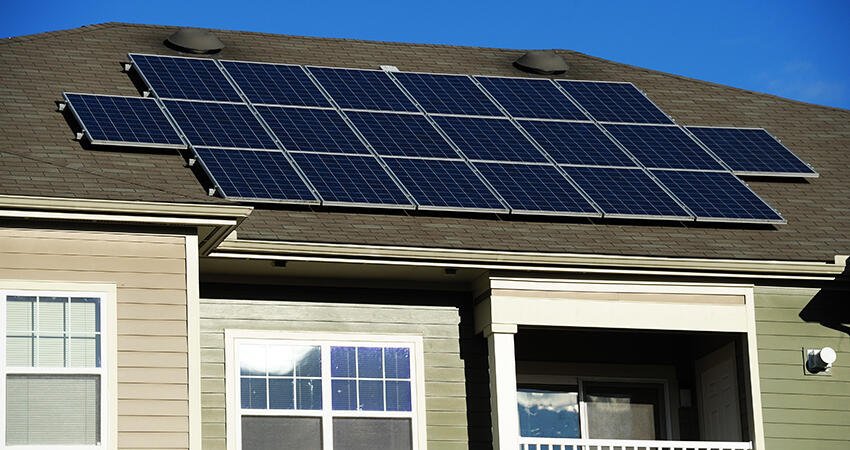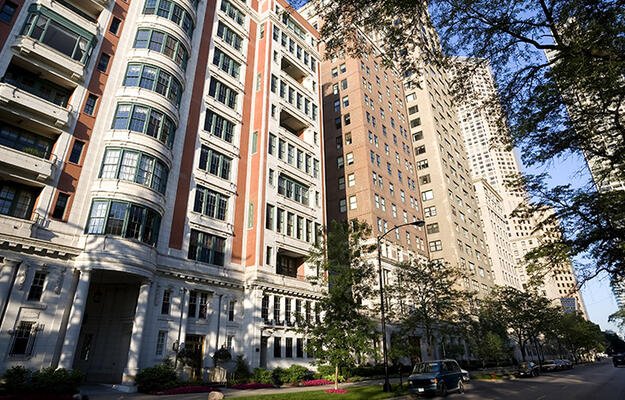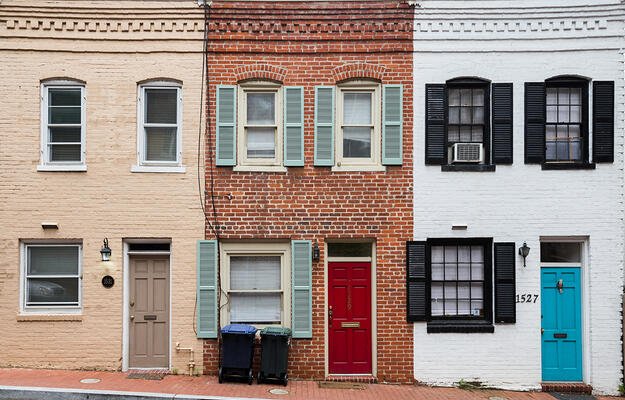
(ND700 / Shutterstock)
We Can’t Address Our Housing Crisis without Addressing Our Climate Crisis
An Expert Q&A with Dana Bourland
The racism embedded in all US systems visibly manifests in our inequitable, inadequate housing system. Housing policies, past and present, contribute to health, education, and economic disparities for Black people, Indigenous people, and other communities of color. Our housing system produces a reality in which residents who work 40 hours a week for minimum wage cannot afford a two-bedroom apartment in any US county (PDF).
The climate change and affordable housing crises are inextricably linked. Our housing stock is a major contributor to climate change: residential buildings account for 20 percent (PDF) of greenhouse gas emissions. And most of this housing is “gray housing,” which serves the immediate, necessary function of providing shelter but is often energy inefficient and adjacent to sites of environmental injustice (PDF), exposing residents to health hazards, including air and water pollution. Gray housing is unhealthy for the planet and threatens residents’ physical and financial health.
Recognizing that we do not have the time or resources to meet our housing crisis without also considering the climate crisis, author Dana Bourland makes the case for green housing in her new book, Gray to Green Communities: A Call to Action on the Housing and Climate Crises. I spoke with Bourland to learn more about her holistic vision for transitioning to affordable, green housing in a way that not only reduces carbon emissions and promotes resource efficiency, but also recognizes the centrality of housing and racial justice for the health and well-being of residents, their communities, and the planet.
In your book, you argue that to achieve housing and environmental systems change and move from gray to green communities, we need to transform both outcomes and processes. One process you point to is integrative design. Could you describe why shifting to integrative, community-centered design is key in the pursuit of green affordable housing?
A transition from gray to green is a process which requires a new way of thinking. Rather than thinking of the end product as a physical structure, the process of green building considers a sweeping set of co-benefits that are only possible when we intentionally set forward to do so. It necessitates bringing a diverse team of stakeholders together before any plans or designs are conceptualized, including people who live in the community and who will be living and working in the building. The design team must then listen to the history of the place, the culture of the community, the conditions of the natural environment, and the needs of the people and respond to what it learns.
The process of green building can evolve how we deliver and rehabilitate housing. We often think of green, affordable housing as an output, a better product. But it is a better process, one that causes less harm and delivers more benefits across the entire process, from energy production, to materials manufacturing, to transporting materials to the job site, to where those materials end up and, ultimately, how the whole process can improve people’s lives and the communities and planet we share. Simply put, green building uses the best of what we know about building science, new technologies, human centered design, construction methods, healthy materials, environmental health, and climate change to deliver the type of housing that will perform maximally for the conditions set forth through the integrative design process to serve the people living in that home and the communities impacted by its development.
A core tenet of both the environmental and housing justice movements is not only racial equity but also antiracist systems change. From the lens of green housing specifically, what do you think the field’s priorities for structural policy change should be?
The priority is to first acknowledge that our housing and development patterns reflect historical practices and policies that segregated communities based on race and class. We need a systems-level approach to address the scale of change required.
By deploying the defining characteristic of green, affordable housing, the integrative design process, the field can begin developing with people instead of developing for people. Instead of developing in a community, we develop with a community. When we stop using the tools and policies of community development to wield power and influence over people, we can imagine and transition into a better place together.
Part of the ripple effect of green, affordable housing is that we can have high-performing housing from an energy and water perspective and from a human one. With one elegant gesture, we can deliver multiple benefits. Let us not squander this opportunity to make massive investments in ways that heal society and advance us toward a racially just and equitable future.
For far too long, housing has been the physical demonstration of the racist systems embedded in our country. Inherently, our policies, programs, and practices that extract wealth, knowledge, and life for the profit and gain of a few have abandoned whole races, peoples, and communities. That same thinking has brought us to the brink of destroying our planet. We must change our way of thinking, not simply enact a new policy.
While we work toward transformation, it’s also essential to mitigate the immediate harms communities are facing because of gray housing and environmental injustice. In the short term, what are the “quick wins,” or ways to get tangible relief, that should be prioritized? How does this look different on the local level versus the federal level?
The climate crisis is a stark reminder that people and the planet have limits. We are tired of being squeezed, left out, unseen, and extracted from to build wealth for an ever shrinking few. We are ready for a just transition to a clean energy future, one where everyone has housing, they can afford, regardless of race or income.
The quickest win is to acknowledge we have a problem and to embrace a new way of thinking about that problem. The way we are producing and rehabilitating housing in this country is not meeting demand, and it is at odds with our collective need to curb carbon emissions. Twenty percent of our carbon emissions in the US stem from heating, cooling, and powering our homes. Once we acknowledge this problem, we can seriously invest in the solution. This goes beyond ensuring we all have a home we can afford. We need to consider who owns the companies developing the housing, the manufacturing facilities making all the building materials, the solar and storage manufacturers and implementer. And we need to make sure that these businesses pay family sustaining wages commensurate with the price of housing in those communities. Who has access to both the homes and the jobs cannot be up to the luck of the draw or your zip code, we must be intentional in delivering a full and equitable transition from gray to green.
The federal government needs to make a national commitment not only to addressing climate change but also to meeting the housing need in this country, and we need the resources and coordinated effort to meet both. At the local level, we must invest in community-based organizations to determine how they want their communities to participate in the transition. Such organizations exist across the country and have the know-how and lived experience to provide solutions. And we must drive resources locally for contractors to simultaneously address health and safety issues in homes and improve energy and water efficiency while adapting these structures for the impacts of climate change. This includes allowing the green infrastructure communities are demanding, from smarter surfaces to natural spaces, that improve overall health and well-being for people and the planet.
In the book, you outline serious challenges to realizing a future of green housing, including an inexperienced and unavailable workforce, lack of transparency about building materials, uncertain and scattered financing, and weak national commitment. What kinds of cross-sector and cross-scale partnerships in the housing field will be essential to overcoming these obstacles? Are there any particularly promising examples or best practices from your work?
Well, the most promising is the use of the Enterprise Green Communities Criteria. Already, 27 housing finance agencies require it, and many other federal and local programs reference it. We need a full commitment to ensure all housing is green, and the Green Communities Criteria are the only green-building standards designed to fit that purpose in a way that keep costs comparable to gray construction while delivering measurable benefits for people and the planet. The criteria work for all housing and construction types in all geographies.
And we must absolutely stop the loss of existing affordable housing by assembling investment vehicles through green banks, community land trusts, or otherwise for communities to acquire the properties, refinance them, and deliver green rehabilitation without the permanent displacement of current residents. These vehicles will have community participation and will result in ownership structures agreed upon by the residents and community. This includes vehicles to support the millions of small landlords who own one or two rental properties, who are often anchors in their communities, as we have witnessed during the pandemic.
There are examples across the entire country of communities who are transitioning from gray to green in ways that address our housing and climate crises. We all benefit from cleaner air, water, and soil and a society where we all have a place to live that we can afford. What we need now is to join together across sectors and commit to making it so.
Dana Bourland is also vice president for environment at the JPB Foundation, a funder of the Housing Matters initiative. The views reflected in this Q&A are those of Bourland.


